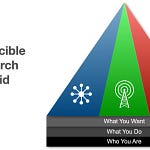
She hadn’t felt motivated at work in a very long time. The initial spark was gone. The honeymoon period was over.
Now, work was just work. She needed the money, so she kept showing up, of course. But, every day left her feeling empty and drained.
She struggled to get out of bed in the morning. What was the point? She asked herself, “Is this all there is to life?”
Some people are lucky enough to find meaning in their jobs. Some have intentionally created an “Invincible Career” to shape their path to only work for companies with a mission that inspires them. So, they feel like their role has purpose.
But, most people have jobs that are a means to an end. It pays the bills. But, that doesn’t mean that you have no choice but to live an uninspired life.
You can take control and create meaning that inspires and motivates you every day, even if your 9-5 job does not. When you design an invincible life, you get to inspire yourself.
It’s too risky to leave the inspiration and motivation to chase your wildest dreams in someone else’s hands. Sooner or later, they will let you down. No one cares about your life and career as much as you do (ok, your mother probably cares a lot too).
You will always be with you on this life journey. You can always count on yourself. So, don’t sit back and wait for someone else to inspire you with their big goals. Create your own audacious goals, motivate yourself, and keep building the Invincible You!
“Your time is limited, so don’t waste it living someone else’s life… Have the courage to follow your heart and intuition. They somehow already know what you truly want to become. Everything else is secondary.”
— Steve Jobs
No matter what you want to accomplish — and before you can make a plan to go after it — you have to know where you are going. Before creating a strategy to get there, you have to know what you want and why.
What is your why?
“There are two ways to build a career or a business. We can go through life hunting and pecking, looking for opportunities or customers, hoping that something connects. Or we can go through life with intention, knowing what our piece looks like, knowing our WHY, and going straight to the places we fit.”
― Simon Sinek, Find Your Why: A Practical Guide for Discovering Purpose for You and Your Team (my affiliate link)
You created your vision of the future in chapter 4. You also created what your mission is that will make that vision come true. This led to a definition of your purpose in life — how you will follow your mission to make your vision of the world come true.
Your purpose is larger and more significant than any temporary project. It’s also more meaningful and personal than the work most of us perform in our 9-5 jobs. More importantly, your purpose belongs to you and gives your life meaning that you own and control. It is your “why.”
That larger sense of purpose is what will inspire you every day. Inspiration occurs when you feel compelled to act because you’re drawn to that vision you want to make come true. Inspiration transcends the self and will make you feel more positive about life. Research has found that inspired people have greater optimism, well-being, creativity, and energy.
“The only way to do great work is to love what you do. If you haven’t found it yet, keep looking and don’t settle.”
— Steve Jobs
Inspiration also creates feelings of enthusiasm, excitement, and hope. And, don’t we all need hope? Hope for a better tomorrow. Hope for a better world. Hope that our lives matter.
Whatever you’ve defined as your purpose, make sure it is large and meaningful. Your “why” should be significant enough to inspire you for the rest of your life.
“Happiness comes from what we do. Fulfillment comes from why we do it.”
― Simon Sinek
The psychology of inspiration
Even though something like inspiration feels too abstract to be scientifically studied, professors Todd Thrash and Andrew Elliot created a model of inspiration as a psychological construct. They conceptualized it as having three core characteristics:
Transcendence
Evocation
Approach motivation
They also proposed that inspiration reflects the combination of two processes:
Being inspired by something. For example, recognizing the intrinsic value of an inspiring vision of how the world could be.
Being inspired to do something. For example, joining a mission to make that inspiring vision come true.
But first, let’s talk about transcendence. It’s one of the essential characteristics of your vision that will help you feel inspired by it. A feeling of transcendence is about gaining an awareness of better possibilities. This is what people mean when they talk about having a “flash of insight” or when a vivid image of a better future pops into their heads.
Next, I want to explain what Thrash and Elliot mean by evocation. It’s the other essential characteristic of your purpose that ensures that you will be inspired by it. It refers to the fact that inspiration is experienced as evoked by an outside influence. It’s what happens when your vision feels larger than yourself.
Your grand vision should be larger than some immediate need (e.g., I want a new car) or shallow ambition (e.g., I want to be rich). What change do you want to see in the world? How do you want to improve the lives of others?
To be inspired, you must evoke a vision of a meaningful goal that is significant and may even require a lifetime to pursue. That may sound intimidating, but having a purpose that you follow for the rest of your life will give your life meaning. It’s what keeps people going.
A lack of purpose is what makes many people give up. It’s also why those who take early retirement don’t live as long as folks who have a reason to get out of bed every day.
Finally, approach motivation compels you to actually do something vs. simply being inspired by your vision. You hope to persuade yourself to take action. Otherwise, what’s the point? You don’t want your vision and mission to remain nothing more than a warm and fuzzy dream.
You want to create a vision of the desired end state and evoke a feeling of significance, then activate and direct your behavior toward the possibilities you’ve described. When you succeed, you’ll feel compelled to make your new idea or vision come true.
Take a moment to review your vision, mission, and purpose from chapter 4 within the context of this psychological framework. Ask yourself these questions:
Does my vision paint a vivid picture of a desirable future?
Is the mission significant enough to feel meaningful?
Have I described a compelling purpose that drives me to make it come true?
Inspiration helps you “plant a flag” on the horizon. It represents the big picture of who you want to help, what problem you want to solve, and who you want to become. It gives you a target, which lets you start defining goals that describe successful progress and achievements on your journey to that flag.
Now, it’s time to translate your vision, mission, and purpose into tangible and realistic goals. You can think of your goals as a sliding target window with the far end in the distant future of what you ultimately want to achieve and the near end focused crisply on the here and now.
Your near-term goals help you define your daily habits, tasks, and activities (I’ll talk about this in a later chapter). What do you need to be doing to achieve them? Your longer-term goals are the ones that will inspire and motivate you to pursue bigger and better things in your life.
Long-term goals
I’m going to make a wild guess that you have a life goal that you would love to achieve, but you’ve been putting off the work to make it happen. I think we all have experienced that.
Why do we put our most important goals on the back burner? I think it happens for a few reasons:
We’re busy with the demands of our daily lives.
There are people who need something from us every day.
We can’t let our work tasks slide.
Significant personal goals feel overwhelming.
We know we want to achieve them but don’t know where to begin.
Personal goals that are important for us don’t have the same urgency as the goals for our job. We want to work on them, but we feel like we don’t have to work on them right now. We’ll get around to it someday.
I get it. It’s easy to get caught up in your 9-5 job. I did too. We often set goals and engage in planning exercises for our employer’s benefit. Even though I run my own business now, I still spend a lot of time working in my business but not on my business.
But, this exercise is about setting goals for you. This effort isn’t for your employer. I want to help you dream, grow, and set yourself up for success. Your goals are an intentional investment in your future!
Why am I asking you to think about your goals for the next few years? Why bother with documenting them now?
Well, because we often keep these long-term life goals bottled up inside and do nothing about them. But, research has found that writing down your goals and committing to them increases your likelihood of success. Accountability is also an incredibly powerful psychological tool, but even more so when we are accountable to others.
The Association for Talent Development performed a study on accountability and found the following probabilities of accomplishing a goal:
10% if you have a goal in mind.
25% if you consciously decide that you will achieve it.
40% if you set a date by which you will achieve it (the point of this chapter).
50% if you create a plan for how you will do it (coming up in a later chapter).
65% if you make a promise to someone else that you will do it (that’s one benefit of my private career community).
95% when you make specific accountability appointments with that person (which is probably why 1-on-1 coaching works so well).
So, what is your most audacious goal? You can whisper it in my ear if you prefer (feel free to send me a message). Have you ever talked about it out loud?
Here’s an exercise that can help you envision that future. Play around with filling in the blank in this statement:
“I wish I could get paid to __________ every day.”
For example:
“I wish I could get paid to write every day.”
“I wish I could get paid to create art every day.”
“I wish I could get paid to network with people every day.”
“I wish I could get paid to think about business strategy every day.”
“I wish I could get paid to bake every day.”
“I wish I could get paid to coach every day.”
Then, expand upon that sentence and create the long-term goal that would make it possible. What needs to happen for that statement to come true? Some examples from a few of my friends:
One wants to become a New York Times bestselling author who makes a living as a writer. She knows this process will take several years, especially since she currently has a different full-time job. But, when she achieves that goal, she will get paid to write every day.
Another friend wants to be the CEO of a successful biotech company. He knows this won’t happen overnight and estimates it will take about 10-15 years to get there. But, when he succeeds, he will get paid to think about business strategy every day.
Another friend wants to leave the corporate world eventually, become a professional chef, and open an award-winning restaurant. When she achieves her most ambitious goal, she will get paid to cook and bake every day.
Now it’s your turn. What do you want to achieve within the next ten years?
Sometimes, your long-term goals will be so audacious that you know you may never reach them (e.g., ending world hunger). But, they serve to inspire you while you do achieve the near-term goals along the way.
However, if you do find yourself performing beyond your wildest dreams and hitting those long-term targets, it will be time to adjust that sliding target window and set your sights on something even more audacious.
As you may have already discovered, achieving goals can sometimes feel like a letdown afterward. You get a sense of, “Ok, now what?”
However, life is about the journey and the striving. We love the “thrill of the chase.” So, set a new long-term goal, if necessary, and refuel your inspiration engine.
A word of caution: some people go a little too crazy with their long-term goals. They have a list of dozens of wild things they want to accomplish. For example, “I want to become a billionaire, walk on the moon, cure cancer, write five bestsellers, play guitar in a rock band and tour the world, and then star in a Hollywood movie about my life.”
Ok, Richard Branson. Good luck!
Instead, I encourage you to select a single goal to place at the top of your list. If you must, list a few related secondary goals.
However, I’ve found that the people who achieve the most are those with a singular vision, mission, and goal. They put all of their energy behind that purpose. So, resist the urge to spread yourself too thin.
What is your highest-priority long-term goal?
Do you feel ready to pursue it? Are you committed to making it happen (why or why not)?
List any secondary long-term goals:
Note: a fuzzy goal will make it harder to create a strategy and plan later (we’ll work on those in later chapters). For example, if your goal is to become one of the greatest authors of all time, what does “greatest” mean? Greatest in terms of what?
The total number of books you publish?
The number of bestsellers you’ve written?
The awards you win?
How much influence your work has on other writers?
How much you’ve earned from your books?
As you might imagine, your strategy and plan would be different for making the most money from your books vs. winning the most awards. So, be as clear and specific as possible with your goals.
Quantitative goals are the easiest to measure, of course. But, in some cases, it will be hard to pin down a qualitative assessment (e.g., I want to feel fulfilled). Even with qualitative success measures, do your best to describe how you will know when you’ve achieved that goal.
What does success specifically look like for your primary goal?
How will you measure success?
How will you know when you’ve achieved your goal?
Mid-term goals
Working backward from your long-term goal, what do you need to accomplish over the next three to five years to make steady progress? Think of these mid-term goals as the stepping stones on the path to your long-term vision. What will set you up for success later?
In chapter 5, you identified the gap between where you are today and where you want to be. So, some of your goals may be focused on what it will take to close that gap. This could include acquiring new skills, knowledge, experience, and connections.
For example, if my friend wants to become a CEO in 10 years, he will first need to establish a track record as a successful executive. No one is promoted straight from individual contributor to CEO. So, his mid-term goals might look like this:
In 2 years, get promoted to Director.
In 3-4 years, get promoted to Senior Director.
In 5 years, land a role as Vice President.
In 7 years, become a Senior Vice President.
In 8-9 years, reach EVP.
By year 10, work with an executive headhunter to connect with companies looking for a CEO.
However, even though I used this as an example, I hope the goals you have in mind aren’t tied to a job title. I’ve talked about this problem before. Reaching a specific level in your career isn’t that meaningful or inspirational. It also leaves you a bit vulnerable since the decision to promote you lies in someone else’s hands.
Now, founding and becoming the CEO of a company solving a meaningful problem in the world is quite different (e.g., researching a cure for cancer). Writing and publishing a book that could change people’s lives can give you a real sense of purpose. Pursuing a goal that will make a difference in the world is inspirational.
What are the biggest goals you want to achieve over the next two to five years? Consider how these goals will pave the way for success for your primary long-term goal.
Year 2:
Year 3:
Year 4:
Year 5:
What does success look like for each of these goals?
How will you measure success?
Goals for this year
Now, let’s pull in your goal-setting window and focus on the next 12 months. This is an exercise I do every January with my premium newsletter subscribers. We identify their goals for the year and then work on strategies and map out plans to achieve them.
I enjoy this exercise because it feels more pragmatic, realistic, and achievable than the longer-term goals. Those larger goals are too big and complex to jump right in and tackle. So, break them down into a series of subgoals and steps you need to build up to achieve them.
Then, map those subgoals into the months of the year. Some of your subgoals and tasks can move forward in parallel, but some must be sequenced.
Here are some examples of annual goals that I’ve heard in the past from clients and community members:
Get promoted into management to start down the path to eventually becoming an executive.
Land a better job that helps them advance their professional development.
Move to a new city that will set them up for a more significant career move later.
Write a book, which will eventually get published and set them on the path to making a living as a writer.
Pursue a new degree that will help them with a significant career change later.
Learn a new language and travel to the country where they want to relocate and retire eventually.
Learn how to cook professionally to prepare for a career pivot into becoming a restaurateur.
Create and teach a workshop that paves the way to launching a new business and eventually quitting their 9-5 job.
Diving deeper into that last one, if your goal for this year is to teach a workshop, you might want to break that down into a series of goals for each month to prepare for that event. For example:
January - Identify the purpose of the workshop.
February - Interview representative ideal customers.
March - Reserve a physical venue to host it.
April - Create the schedule and outline.
May - Develop your workshop content.
Etc.
In chapter 5, you also identified blockers and barriers standing between you and your long-term goals. They might be holding you back from pursuing your vision. So, some of your goals this year may need to be focused on eliminating those barriers before you can make progress. Take a moment and map all of your subgoals into the months ahead.
January
February
March
April
May
June
July
August
September
October
November
December
As I recommended earlier, try to find an accountability partner or a supportive community to improve your odds of success. My resources page for this book provides some links to explore and learn more.
Goals for next quarter
The monthly goals for the year can seem a little high-level, so now it’s time to go into more detail for the next three months. What do you want to focus on during the upcoming quarter? What are the subgoals you want to achieve?
I know. This starts to feel a bit like a planning exercise, which we will cover in a later chapter. But, the distinction is that we’re still talking about the “what” of what you want to achieve and not the “how” of what you will actually do to accomplish those goals.
For now, simply document these subgoals, so you have them ready for the later planning effort. What do you want to prioritize for the next three months?
Month 1
Month 2
Month 3
Goals for the next 30 days
Finally, focus on the upcoming month. Break your subgoals for that month into weekly goals. What do you want to accomplish every week to stay on track for the quarter (and eventually the year)?
Week 1
Week 2
Week 3
Week 4
This goal-setting may feel overwhelming, but it gets easier and feels more natural the more you work on it. You might also wonder why I’m asking you to keep breaking your big audacious goal down into smaller goals and even smaller subgoals.
I recommend this approach because most people never achieve their dreams. They never accomplish the most important goals they want for their lives.
“The mass of men lead lives of quiet desperation.”
— Henry David Thoreau
Some people give up before they even get started. They let their goals float around in their heads as wishful dreams and never commit to them at all.
Other people leap into tasks they think will take them straight to that audacious end state. But that’s like trying to scale the peak of Mount Everest with no strategy, planning, training, guides, or basecamps along the way. They set themselves up for failure by trying to do it all at once.
Instead, I want you to succeed. I want you to achieve your biggest dreams. So, that’s why this goal-setting chapter went into so much detail.
Now, a goal without a plan is simply a dream. If you don’t develop a strategy for achieving your goals, they’ll never be more than wishful thinking. We’ll dive into that phase in the next chapter.
I’m looking forward to sharing more of my book with you this year! Become a premium subscriber today to keep reading the draft chapters as I complete them.
By the way, there is a great way you can support my work without spending any money on a premium subscription:
📣 Recommending my newsletter on social media! 📣
It only takes a few seconds, and it helps grow my business so I can continue making time to write it.
I’ll even provide some copy and paste text to make it easy to share on Twitter, Reddit, LinkedIn, Facebook, etc. Thanks in advance!
I've really been enjoying the Invincible Career newsletter by Larry Cornett (@cornett). If you want to get ahead at work and be happier in your job, but you aren’t subscribed yet, you’re missing out.
https://newsletter.invinciblecareer.com
Larry Cornett is a leadership coach and business advisor who hosts a private mastermind community for ambitious professionals with weekly challenges, office hours, and confidential support. If you’re interested in starting your own business or side hustle someday (or accelerating an existing one), check out his “Employee to Solopreneur” course (launching later this year).
Larry lives in Northern California near Lake Tahoe with his wife and children, and a gigantic Great Dane. He does his best to share advice to help others take complete control of their work and life. He’s also on Twitter @cornett.














Book Chapter - Identifying Your Audacious Goals (Issue #371)